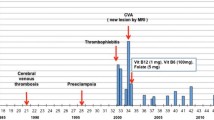Abstract.
A number of studies have identified elevated levels of homocysteine (Hcy) as a risk factor for thrombosis. Given the relationship between Hcy and thrombosis, a high prevalence of thrombosis would be expected in patients with megaloblastic anemia. The aim of our study was to determine whether an acquired vitamin B12/folate deficiency is a risk factor for thrombosis. A retrospective case and control study was performed that included 193 cases with reduced levels of vitamin B12/folate. The cases were divided initially into two groups (105 with serum vitamin B12 ≤150 pmol/l and/or low red cell folate ≤450 nmol/l and 88 with serum vitamin B12 between 150 and 200 pmol/l and/or red cell folate between 450 and 590 nmol/l). The control group consisted of 87 additional patients who had normal levels of serum vitamin B12, red cell folate, and normal renal function. Serum Hcy, thrombotic events, and risk factors were evaluated in all participants. Eight patients (9%) in the control group had had previous vascular events although only three of these events (37.5%) were observed between the vitamin study and 2 years prior to the study. In the case group, 20% of the patients had a history of thrombosis. In contrast with controls, 85% of cases suffered thrombosis between the time they were diagnosed and 2 years prior to the time they were diagnosed as showing a vitamin deficiency. Multivariate analysis demonstrated that vitamin deficiency was a significant risk factor for arterial thrombosis [adjusted odds ratio (OR) 3.3, confidence interval (CI) 1.1–10.2]. However, when hyperhomocysteinemia was included in the analysis, vitamin deficiency was no longer a risk factor, suggesting that hyperhomocysteinemia was responsible for arterial thrombotic risk in these patients (adjusted OR 2.5, CI 1.1–5.8). As a consequence of hyperhomocysteinemia, patients with acquired vitamin deficiency of vitamin B12/folate had a high risk of thrombosis. However, a more extensive study that controls risk variables and genetic factors is needed to sort out the various contributing factors.
Similar content being viewed by others
Author information
Authors and Affiliations
Additional information
Electronic Publication
Rights and permissions
About this article
Cite this article
Remacha, .A., Souto, .J., Rámila, .E. et al. Enhanced risk of thrombotic disease in patients with acquired vitamin B12 and/or folate deficiency: role of hyperhomocysteinemia. Ann Hematol 81, 616–621 (2002). https://doi.org/10.1007/s00277-002-0560-6
Received:
Accepted:
Issue Date:
DOI: https://doi.org/10.1007/s00277-002-0560-6




